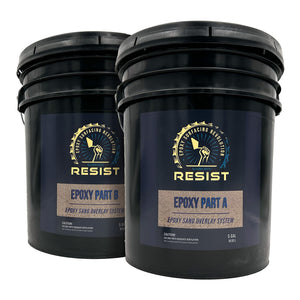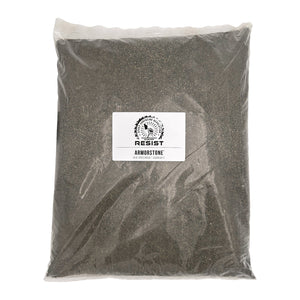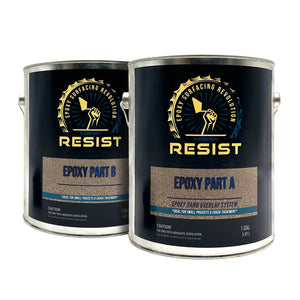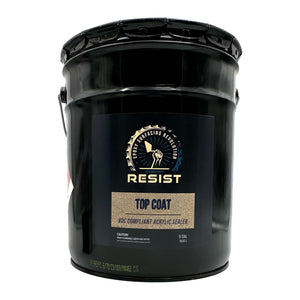SureCrete RESIST Repair Mortar (50 lb)

About
SureCrete RESIST Repair Mortar is a single-component, high compressive strength, self-bonding, cement-based patching compound that sets up rapidly, with a 10-minute working time.
Due to its relatively fine aggregate (sand), it may be feathered nearly to zero. RESIST Repair Mortar may be overlaid or put in service the same day the patch is applied; there is no lengthy cure time required (see timelines below). This product offers superior bonding power without additional bonding agents, able to patch low spots, divots, and spalls in concrete floors. RESIST Repair Mortar is designed for heavy traffic repairs, as it has the resilience to patch commercial loading docks, parking lots, walkways, entryways and parking garages.
The SureCrete RESIST Epoxy Sand Overlay System
SureCrete’s RESIST is a 100% active, low modulus, two-component epoxy overlay system that when combined with a kiln-dried, properly sourced wear surface aggregate, produces a reliant overlay with benefits not found in traditional concrete overlays.
- Tenacious bond strength creating a durable, slip-resistant overlay system
- Superior resiliency and impact / wear resistance
- Bonds directly with the surface for exceptional chemical resistance and waterproofing
- Non-shrink and flexible enough to withstand slight movement and extreme temperature changes
- Cost effective with a 20 year history of high performance, repairs in the most extreme conditions
- Easy to use 1:1 mixing ratio
- Complete system that provides compatible products for crack repair, surface defects as well as a non-yellowing, color enhancing, protective top coat
See all of the products in the SureCrete RESIST Epoxy Sand Overlay System
Specs
Coverage
1-50 lb. (22.7 kg) bag = approx. 11ft2 at 1/2" (1m2 at 13mm)
Coverage rates are provided as a guideline only. Many factors including surface texture, porosity and weather conditions will determine actual coverage rates.
Temperature/Cure
- Air and substrate surface temperatures shall range between 40°F (10°C) and 85°F (29°C) during placement and remain within range for a minimum of 4 hours after placement.
- No precipitation should occur during or within 3 hours of placement.
- Temperature must remain above freezing for a minimum of 24 hours after placement.
- Cure / set times at 77°F (25°C) ambient temperature
- Initial set in 15-25 minutes
- Light traffic in 45-60 minutes
- Heavy traffic in 3-6 hours
Testing Data
DENSITY
128 pounds / ft3 (2047 kg/m3)
COMPREHENSIVE STRENGTH - ASTM C-109
3 hour 3090 PSI (21340 kPa)
24 hour 4850 PSI (33440 kPa)
28 days 6042 PSI (41660 kPa)
FLEXURAL STRENGTH - ASTM C-348
6 hour 300 PSI (2069 kPa)
7 days 685 PSI (4723 kPa)
TENSILE STRENGTH - ASTM C-190
6 hour 275 PSI (1896 kPa)
7 days 495 PSI (3413 kPa)
Shelf Life
Under normal conditions: when kept dry and moisture free, out of direct sunlight, the shelf life of an unopened container is 12 months from the purchase date. Storage must be under roof and off the floor. Avoid temperature extremes. Rotate inventory to maintain product that is within limits.
Instructions
Surface Prep
The principles for surface penetration for RESIST Repair Mortar are aligned with cement-based overlays placed on concrete and remain constant; the substrate must be:
- CLEAN
The surface must be free of dust, dirt, oil, grease, paints, glues, sealers, curing agents, efflorescence, chemical contaminants, rust, algae, mildew and other foreign matter that may serve as a bond breaker. - CURED
Any concrete must be sufficiently cured to have sufficient hydration, approximately 7-14 days depending on temperatures and humidity. - SOUND
No system should be placed upon concrete that is flaking, spalling, or has hibernating spalling. - PROFILED
Proper profile should follow the standard established by the International Concrete Repair Institute (ICRI) Technical Guideline no. 03732 for Concrete Surface Profile (CSP).
The established profile categorized as CSP-1 through CSP-4. The most common means to properly profile many concrete slabs (especially exterior slabs) is through use of a pressure washer equipped with a turbo-tip and the use of SureCrete SCR.
Some concrete slabs that are hard troweled or that are not sound may require more aggressive profiling through diamond grinding or shot blasting.
Mixing/Application
- Commonly, full 50 lb. bags of RESIST Repair Mortar, may not be required for patching your surface. Ensure opened bags are kept in a sealed container.
- No more material should be mixed than can be placed in 10 minutes.
- Weighing dry bag mix with a scale is the most accurate, what follows below will work with volumetric measuring alone.
SMALL BATCH (1 qt. dry / .95 liter dry)
- Add 8oz. or 1 cup (.24 liter) water for each 1 qt. dry (.95 liter) RESIST Repair Mortar to an appropriately sized vessel.
- Begin adding dry mix to water while running mixer. Mix with an appropriately sized mixer (from a cordless drill with a "jiffy" style to a heavy-duty mixer of 1/2" (12.7 mm) 45-600 rpm drill equipped with a cage mixing blade).
- Scrape side of pail with a margin trowel to ensure all dry product is incorporated into the wet mix.
- Continue to mix for a minimum of 30 seconds after all ingredients are combined to achieve a lump-free consistency. Additional water may be added up to a total of 9 oz (.27 liter) water to 1 qt. (.95 liter) dry mix.
LARGE BATCH (Full Bag)
- Add approximately 4 quarts (3.8 liter) water to a 5 gal. (18.9 liter) bucket.
- Slowly introduce RESIST Repair Mortar into the bucket with mixer running. Use a hand-held concrete mixer like a 1/2" (12.7 mm) 450-600 rpm drill equipped with a cage mixing blade.
- Scrape side of pail with a margin trowel to ensure all dry product is incorporated into the wet mix.
- Continue to mix for a minimum of 1 minute after all ingredients are combined to achieve a lump-free consistency. Additional water may be added up to a total of 4.5 quarts (4.3 liter) water to 1 - 50 lb. (22.7 kg) bag of RESIST Repair Mortar.
- No tempering with additional water should be attempted.
PATCHING APPLICATION
Note: Before applying RESIST Repair Mortar, the surface should be saturated surface dry with clean water (SSD, or damp, no puddles).
- Trowel by hand or squeegee product tightly into patched area, as quickly as is reasonable. Minimize troweling, do not overwork the surface.
- To ensure a surface that provides a sufficient texture for bonding, we suggest:
- Broadcasting RESIST approved wear surface aggregate into the surface of the Repair Mortar while it is still workable.
- Roughen up the surface to create a texture suitable for proper bonding.
- Allow product to dry sufficiently before placement of any overlay, usually 1-2 hours (depending on surface porosity, temperature and amount of material used).
- Before applying an overlay, be certain that the patched surface is no longer generating excessive heat from its curing. If applying a coating or sealer, 24 hours is recommended.




